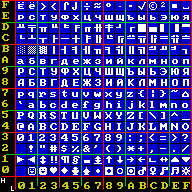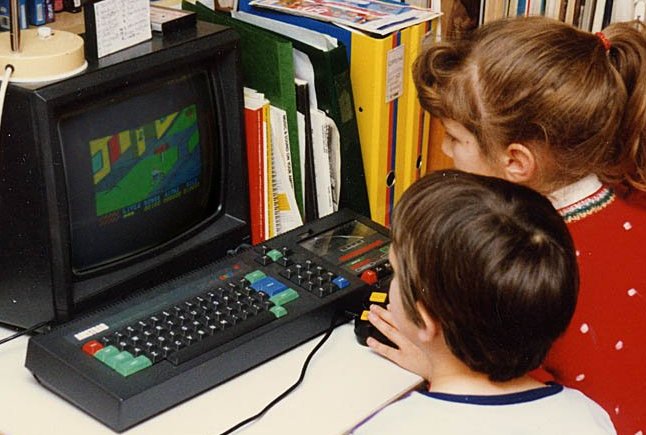|
Indexed Color
In computing, indexed color is a technique to manage digital images' colors in a limited fashion, in order to save computer computer data storage, memory and Hard disk drive, file storage, while speeding up display refresh and file transfers. It is a form of Vector quantization#Use in data compression, vector quantization compression. When an image is encoding, encoded in this way, color information is not directly carried by the image pixel data, but is stored in a separate piece of data called a color lookup table (CLUT) or Palette (computing), palette: an array of color specifications. Every element in the array represents a color, indexed by its position within the array. Each image pixel does not contain the full specification of its color, but only its index into the ''palette''. This technique is sometimes referred as pseudocolor or indirect color, as colors are addressed indirectly. History Early graphics display systems that used 8-bit indexed color with frame buffers ... [...More Info...] [...Related Items...] OR: [Wikipedia] [Google] [Baidu] [Amazon] |
Nibble
In computing, a nibble, or spelled nybble to match byte, is a unit of information that is an aggregation of four- bits; half of a byte/ octet. The unit is alternatively called nyble, nybl, half-byte or tetrade. In networking or telecommunications, the unit is often called a semi-octet, quadbit, or quartet. As a nibble can represent sixteen () possible values, a nibble value is often shown as a hexadecimal digit (hex digit). A byte is two nibbles, and therefore, a value can be shown as two hex digits. Four-bit computers use nibble-sized data for storage and operations; as the word unit. Such computers were used in early microprocessors, pocket calculators and pocket computers. They continue to be used in some microcontrollers. In this context, 4-bit groups were sometimes also called characters rather than nibbles. History The term ''nibble'' originates from its representing half a byte, with ''byte'' a homophone of the English word ''bite''. In 2014, David B. Be ... [...More Info...] [...Related Items...] OR: [Wikipedia] [Google] [Baidu] [Amazon] |
List Of Palettes
This article is a list of the color palettes for notable computer graphics, terminals and video game console hardware. Only a sample and the palette's name are given here. More specific articles are linked from the name of each palette, for the test charts, samples, simulated images, and further technical details (including references). In the past, manufacturers have developed many different display systems in a competitive, non-collaborative basis (with a few exceptions, as the VESA consortium), creating many proprietary, non-standard different instances of display hardware. Often, as with early personal and home computers, a given machine employed its unique display subsystem, with its also unique color palette. Also, software developers had made use of the color abilities of distinct display systems in many different ways. The result is that there is no single common standard nomenclature or classification taxonomy which can encompass every computer color palette. In orde ... [...More Info...] [...Related Items...] OR: [Wikipedia] [Google] [Baidu] [Amazon] |
Home Computer
Home computers were a class of microcomputers that entered the market in 1977 and became common during the 1980s. They were marketed to consumers as affordable and accessible computers that, for the first time, were intended for the use of a single, non-technical user. These computers were a distinct market segment that typically cost much less than business, scientific, or engineering-oriented computers of the time, such as those running CP/M or the IBM PC, and were generally less powerful in terms of computer memory, memory and expandability. However, a home computer often had better video display controller, graphics and sound than contemporary business computers. Their most common uses were word processing, playing video games, and computer programming, programming. Home computers were usually sold already manufactured in stylish metal or plastic enclosures. However, some home computers also came as commercial electronic kits, like the ZX80, Sinclair ZX80, which were both h ... [...More Info...] [...Related Items...] OR: [Wikipedia] [Google] [Baidu] [Amazon] |
Personal Computer
A personal computer, commonly referred to as PC or computer, is a computer designed for individual use. It is typically used for tasks such as Word processor, word processing, web browser, internet browsing, email, multimedia playback, and PC game, gaming. Personal computers are intended to be operated directly by an end user, rather than by a computer expert or technician. Unlike large, costly minicomputers and mainframes, time-sharing by many people at the same time is not used with personal computers. The term home computer has also been used, primarily in the late 1970s and 1980s. The advent of personal computers and the concurrent Digital Revolution have significantly affected the lives of people. Institutional or corporate computer owners in the 1960s had to write their own programs to do any useful work with computers. While personal computer users may develop their applications, usually these systems run commercial software, free-of-charge software ("freeware"), which i ... [...More Info...] [...Related Items...] OR: [Wikipedia] [Google] [Baidu] [Amazon] |
Adaptative 8bits Palette
Adaptive behavior is behavior that enables a person (usually used in the context of children) to cope in their environment with greatest success and least conflict with others. This is a term used in the areas of psychology and special education. Adaptive behavior relates to everyday skills or tasks that the "average" person is able to complete, similar to the term life skills. Nonconstructive or disruptive social or personal behaviors can sometimes be used to achieve a constructive outcome. For example, a constant repetitive action could be re-focused on something that creates or builds something. In other words, the behavior can be adapted to something else. In contrast, maladaptive behavior is a type of behavior that is often used to reduce one's anxiety, but the result is dysfunctional and non-productive coping. For example, avoiding situations because you have unrealistic fears may initially reduce your anxiety, but it is non-productive in alleviating the actual problem i ... [...More Info...] [...Related Items...] OR: [Wikipedia] [Google] [Baidu] [Amazon] |
Dither
Dither is an intentionally applied form of noise used to randomize quantization error, preventing large-scale patterns such as color banding in images. Dither is routinely used in processing of both digital audio and video data, and is often one of the last stages of mastering audio to a CD. A common use of dither is converting a grayscale image to black and white, so that the density of black dots in the new image approximates the average gray level in the original. Etymology The term ''dither'' was published in books on analog computation and hydraulically controlled guns shortly after World War II. Though he did not use the term ''dither'', the concept of dithering to reduce quantization patterns was first applied by Lawrence G. Roberts in his 1961 MIT master's thesis and 1962 article. By 1964 dither was being used in the modern sense described in this article. The technique was in use at least as early as 1915, though not under the name ''dither''. In digital pro ... [...More Info...] [...Related Items...] OR: [Wikipedia] [Google] [Baidu] [Amazon] |
Colour Banding
Colour banding is a subtle form of posterization in digital images, caused by the colour of each pixel being rounded to the nearest of the digital colour levels. While posterization is often done for artistic effect, colour banding is an undesired artifact. In 24-bit colour modes, 8 bits per channel is usually considered sufficient to render images in Rec. 709 or sRGB. However the eye can see the difference between the colour levels, especially when there is a sharp border between two large areas of adjacent colour levels. This will happen with gradual gradients (like sunsets, dawns or clear blue skies), and also when blurring an image a large amount. Colour banding is more noticeable with fewer bits per pixel (BPP) at 16–256 colours (4–8 BPP), where there are fewer shades with a larger difference between them. Possible solutions include the introduction of dithering and increasing the number of bits per colour channel. Because the banding comes from lim ... [...More Info...] [...Related Items...] OR: [Wikipedia] [Google] [Baidu] [Amazon] |
Gradient
In vector calculus, the gradient of a scalar-valued differentiable function f of several variables is the vector field (or vector-valued function) \nabla f whose value at a point p gives the direction and the rate of fastest increase. The gradient transforms like a vector under change of basis of the space of variables of f. If the gradient of a function is non-zero at a point p, the direction of the gradient is the direction in which the function increases most quickly from p, and the magnitude of the gradient is the rate of increase in that direction, the greatest absolute directional derivative. Further, a point where the gradient is the zero vector is known as a stationary point. The gradient thus plays a fundamental role in optimization theory, where it is used to minimize a function by gradient descent. In coordinate-free terms, the gradient of a function f(\mathbf) may be defined by: df=\nabla f \cdot d\mathbf where df is the total infinitesimal change in f for a ... [...More Info...] [...Related Items...] OR: [Wikipedia] [Google] [Baidu] [Amazon] |
Color Quantization
In computer graphics, color quantization or color image quantization is quantization applied to color spaces; it is a process that reduces the number of distinct colors used in an image, usually with the intention that the new image should be as visually similar as possible to the original image. Computer algorithms to perform color quantization on bitmaps have been studied since the 1970s. Color quantization is critical for displaying images with many colors on devices that can only display a limited number of colors, usually due to memory limitations, and enables efficient compression of certain types of images. The name "color quantization" is primarily used in computer graphics research literature; in applications, terms such as ''optimized palette generation'', ''optimal palette generation'', or ''decreasing color depth'' are used. Some of these are misleading, as the palettes generated by standard algorithms are not necessarily the best possible. Algorithms Most standar ... [...More Info...] [...Related Items...] OR: [Wikipedia] [Google] [Baidu] [Amazon] |
List Of Monochrome And RGB Color Formats
This list of monochrome and RGB palettes includes generic repertoires of colors (color palettes) to produce black-and-white and RGB color pictures by a computer's display hardware. RGB is the most common method to produce colors for displays; so these complete RGB color repertoires have every possible combination of R-G-B triplets within any given maximum number of levels per component. Each palette is represented by a series of color patches. When the number of colors is low, a 1-pixel-size version of the palette appears below it, for easily comparing relative palette sizes. Huge palettes are given directly in one-color-per-pixel color patches. For each unique palette, an image color test chart and sample image ( truecolor original follows) rendered with that palette (without dithering) are given. The test chart shows the full 256 levels of the red, green, and blue (RGB) primary colors and cyan, magenta, and yellow complementary colors, along with a full 256-level grayscale. ... [...More Info...] [...Related Items...] OR: [Wikipedia] [Google] [Baidu] [Amazon] |





